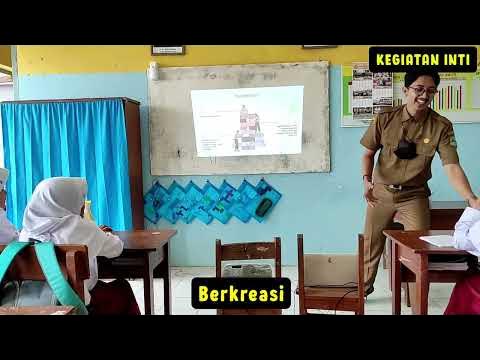Model Pembelajaran Think Pair and Share - Andin Rizki Aulia
Summary
TLDRThis video explains the Think-Pair-Share (TPS) cooperative learning model, emphasizing its benefits for making learning more interactive and student-centered. The model encourages individual reflection, pair discussions, and group sharing, boosting engagement and confidence. The teacher sets the stage by posing a question, allowing students to think, pair up to discuss, and share their ideas. TPS fosters critical thinking, active participation, and collaboration. While the model has numerous advantages, such as promoting student involvement, it also poses challenges like the need for effective coordination and planning, especially with odd-numbered students.
Takeaways
- 😀 Introduction to the speaker: Andi Rizky Aulia, a student of IPS Education, presenting on the Think-Pair-Share (TPS) model.
- 😀 Emphasis on the importance of staying safe and following health guidelines, especially during the COVID-19 pandemic.
- 😀 A greeting to viewers and well wishes for those observing fasting during Ramadan.
- 😀 Overview of the Think-Pair-Share (TPS) model, a cooperative learning model that aims to make learning more effective and enjoyable.
- 😀 The TPS model consists of three main steps: Think (individual thinking), Pair (pairing with a classmate for discussion), and Share (sharing answers with others or the class).
- 😀 The model encourages active student participation and enhances their confidence in expressing ideas.
- 😀 The first step in TPS: The teacher introduces the rules and goals, and motivates students to get involved in the learning process.
- 😀 The second step: Students are given a question to think about individually, often writing down their answers on paper.
- 😀 The third step: Pairing students to discuss their individual answers, allowing them to compare and collaborate on finding the best response.
- 😀 The fourth step: Sharing answers with the class or other groups, fostering communication and collaboration among students.
- 😀 The final step involves providing recognition and rewards, both individually and for the group, and concluding the lesson with feedback and assignments.
Q & A
What is the Think-Pair-Share (TPS) model of learning?
-The Think-Pair-Share (TPS) model is a cooperative learning strategy designed to make learning more effective and enjoyable. It involves three steps: Think (students think individually), Pair (students discuss with a partner), and Share (students present their ideas to the class).
What are the three key steps involved in the TPS model?
-The three key steps in the TPS model are: 1) Think - students think individually, 2) Pair - students pair up with a partner to discuss their answers, and 3) Share - students share their answers with the class or other pairs.
What is the first step in implementing the TPS model in a classroom?
-The first step is the Introduction stage, where the teacher sets the rules, motivates the students, and presents a question related to the lesson to engage the class.
How does the Think stage work in TPS?
-In the Think stage, students work individually to think about the question or topic posed by the teacher. They write down their answers, allowing for independent thought before discussing with others.
What happens during the Pair stage of the TPS model?
-In the Pair stage, students partner with a classmate to discuss their individual answers. They compare their ideas and may combine them to form a better response.
What is the purpose of the Share stage in TPS?
-The Share stage allows students to present their answers to the class or to other pairs. This stage encourages students to articulate their thoughts and practice public speaking.
What are the advantages of using the Think-Pair-Share model?
-The TPS model promotes active participation, boosts student confidence in sharing ideas, enhances teamwork, and helps students practice accepting and considering others' viewpoints.
What are the main disadvantages of the TPS model?
-The main disadvantages include the need for good coordination between the teacher and students, difficulties with odd numbers of students, and challenges in engaging students who are used to traditional learning methods.
How does the teacher motivate students in the TPS model?
-The teacher motivates students by providing clear instructions, encouraging participation, and giving them opportunities to actively engage with the content, ensuring they are confident in contributing.
How does the TPS model help students improve their communication skills?
-The TPS model enhances communication skills by encouraging students to think independently, collaborate with a partner, and present their ideas to the class, thereby improving both speaking and listening abilities.
Outlines

This section is available to paid users only. Please upgrade to access this part.
Upgrade NowMindmap

This section is available to paid users only. Please upgrade to access this part.
Upgrade NowKeywords

This section is available to paid users only. Please upgrade to access this part.
Upgrade NowHighlights

This section is available to paid users only. Please upgrade to access this part.
Upgrade NowTranscripts

This section is available to paid users only. Please upgrade to access this part.
Upgrade Now5.0 / 5 (0 votes)





